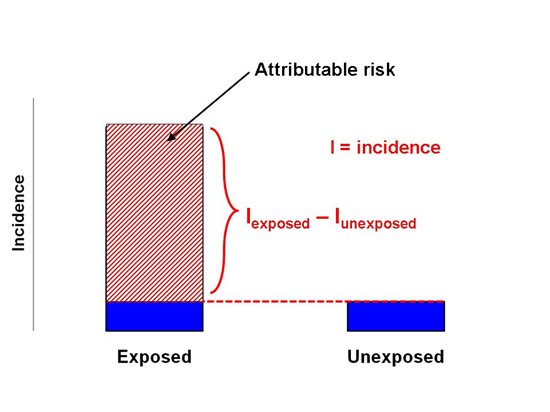Quantifying disease burden
Contents
Introduction
The effect of a health hazard on a population depends on two things:
- the size of the risk for exposed individuals (relative risk)
- the number of individuals exposed (prevalence of exposure).
The product of these two factors is known as the population-attributable risk.
If an exposure is uncommon, then the disease burden within the population will be small, no matter how great the risk to the individual, e.g. bat bites and rabies.
If an exposure is common, then the disease burden within the population may be large, even if the risk to the individual is small, e.g. egg consumption and infection with Salmonella Enteritidis [1].
The population-attributable risk is an important public health concept since it provides a measure of the impact of the exposure on the population as a whole. It also indicates the reduction in disease burden that could be achieved if the risk factor was controlled or eliminated by effective preventive action.
Relative risk versus attributable risk
Risk can be expressed in relative terms (relative risk, standardised mortality ratio) or in absolute terms (absolute risk, number needed to treat) [2].
The relative risk(risk ratio) is the most commonly used measure of the effect of an exposure on an individual's risk of disease. It is the ratio of disease occurrence (incidence) in exposed people to the occurrence of disease in unexposed people.
The attributable risk is used to measure the public health impact of the exposure on the population as a whole, once a link between the exposure and the occurrence of disease has been established. It also indicates the potential impact of control measures.
There are two ways of measuring attributable risk:
a) the attributable risk among the exposed (ARe)
b) the attributable risk in the population (ARpop)
The attributable risk among the exposed (ARe)
This is the proportion of cases among exposed individuals that can be attributed to the exposure.
Figure 1. Schematic illustration of attributable risk among the exposed
The attributable risk in the population (ARpop)
This is the proportion of cases in the general population that can be attributed to the exposure, and therefore prevented if an intervention exists.
Figure 2. Schematic illustration of population-attributable risk
References
Credits
Fem Editor 2007
- Meirion Evans
original Authors
- Alain Moren
- Marta Valenciano
- Thomas Grein
FEM Contributors
Root > Assessing the burden of disease and risk assessment > Field Epidemiology > Measurement in Field Epidemiology > Measures of Disease Impact

